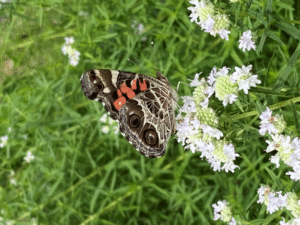(Photos and story by Diane De Luca)
In the early days of spring, we are often greeted with the first emergence of the Mourning Cloak butterfly. What a gift as we look forward to the many other spring happenings. But how do they appear so early, sometimes before March has even faded away? Where do butterflies go in the winter? What strategies do they use to survive?
Many of us are familiar with the epic fall migration of the Monarch butterfly as they make their way from the US and Canada to the forests of central Mexico. A journey of close to 3,000 miles. The last summer generation of Monarchs will spend their winter in these high elevation forests. As the days get longer in spring, the Monarchs will begin their journey back north and lay eggs in the southern parts of the US. A second generation of hatched adults will continue the northward migration. Another species that undertakes a migration is the American Lady. The American Lady is known to migrate northward from southern states in the spring, but any southward migration is much reduced. The adults cannot overwinter in cold climates, but some pupa may survive. Spring populations are mainly from northward migration.

The Monarch and American Lady are examples of the few butterflies that are known to migrate when cold temperatures invade the northeast. Most, similar to the Mourning Cloak, overwinter in some form here in New Hampshire. The Mourning Cloak early emergence is possible because they spend the cold months in adult form. They find safe places to overwinter such as cracks in rocks or under tree bark. Protected from freezing temperatures by glycol, essentially an antifreeze, they are able to slow down their body processes to remain dormant until spring.
Many other butterflies will form a chrysalis in the waning days of summer, emerging after the weather warms in the spring. Butterflies who spend the winter in a chrysalis find a protected place among tree branches, tucked into thick shrubbery or under an overhang. Like the adult Mourning Cloak, they contain glycol to prevent freezing, and can slow down development. When warm weather returns, the chrysalis growth continues and timing of hatch coincides with nectar resources. Butterflies that use this strategy in New Hampshire include the Eastern (or Canadian) Tiger Swallowtail, Black Swallowtail and Spicebush Swallowtail: all large and showy butterflies that brighten our pollinator landscapes through the summer.
Still others, amazingly enough, will overwinter as eggs or caterpillars. The Great Spangled Fritillary lays its eggs in late summer near or at the base of violets, the primary host plant for this species. The newly hatched caterpillar will spend the winter buried in the leaf litter or soil surrounding the violets. In early spring as the violet leaves emerge, the caterpillar will feed on these new leaves and continue to grow. Perhaps most remarkable are the species that overwinter as eggs. Similar to the caterpillars, the eggs will be laid at the base of the host plant to spend the winter in the leaf litter or soil. A number of the gossamer-winged butterflies such as the Banded Hairstreak and Bronze Copper lay eggs in fall under preferred host plants. Growth begins as temperatures warm in the spring. A good reminder of the importance of leaving the leaf litter and soil around our garden plants undisturbed in fall and winter.
We are excited to share that New Hampshire Audubon will partner with New Hampshire Fish and Game to train volunteers to participate in the first annual Concord Area Butterfly Survey that will take place in July of 2023. Stay tuned for details coming soon.
